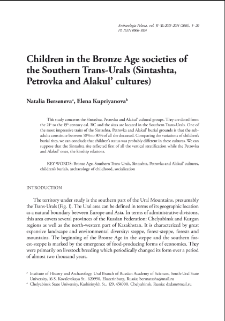- Search in all Repository
- Literature and maps
- Archeology
- Mills database
- Natural sciences
Advanced search
Advanced search
Advanced search
Advanced search
Advanced search

Object
Title: Children in the Bronze Age societies of the Southern Trans-Urals (Sintashta, Petrovka and Alakul’ cultures)
Subtitle:
Archaeologia Polona Vol. 51-52 (2013-2014)
Publisher:
Institute of Archaeology and Ethnology Polish Academy of Sciences
Place of publishing:
Description:
Type of object:
Abstract:
This study concerns the Sintashta, Petrovka and Alakul’ cultural groups. They are dated from the 21st to the 15th century cal. BC and the sites are located in the Southern Trans-Urals. One ofthe most impressive traits of the Sintashta, Petrovka and Alakul’ burial grounds is that the subadults constitute between 50% to 80% of all the deceased. Comparing the variations of children’s burial rites, we can conclude that children’s status was probably different in these cultures. We can suppose that the Sintashta rite reflected first of all the vertical stratification while the Petrovka and Alakul’ ones, the kinship relations
References:
Berseneva, N. 2010. Child Burials during the Middle Bronze Age of South Urals (Sintashta Culture). In L.H. Dommasnes, T. Hjorungdal, S. Monton-Subias, M. Sanchez Romero and N.L. Wicker (eds), Situating Gender in the European Archaeologies, Budapest, 161-180
Berseneva, N. (in press). Children’s burials with weaponry during the Ural Bronze Age (Sintashta culture)
Bocharov, V.V. 2001 Antropologia vozrasta (The Anthropology of Age), St. Petersburg
Epimakhov, A.V. 2005. Rannie kompleksnye obshestva severa Zentralnoi Evrasii (po materialam mogil’nika Kamennyi Ambar-5), Chelyabinsk
Gening, V.F., Zdanovich, G.B. and Gening, V.V. 1992. Sintashta: Archaeological Sites of Aryan Tribes of the Ural-Kazakhstan Steppes, Chelyabinsk
Kamp, K.A. 2001. Where Have All the Children Gone? The Archaeology of Childhood, Journal of Archaeological Method and Theory 8 (1), 1–33
Koryakova, L.N. and Epimakhov, A.V. 2007. The Urals and Western Siberia in the Bronze and Iron Ages, Cambridge
Kupriyanova E.V. 2008. Ten’ zhenshiny: zhenskyi kostyum bronzovogo veka kak ‘tekst’ (po materialam nekropoley Yuzhnogo Zaural’ya i Kazakhstana) (Shadow of a woman: female Bronze Age costume as ‘a text’ (after materials of necropolis of South Ural and Kazakhstan)), Chelyabinsk
Kupriyanova, E.V. and Zdanovich, D.G. 2015. Drevnosti lesostepnogo Zaural’ya: mogil’nik Stepnoye VII (Antiquities of the forest-steppe Trans-Urals: Stepnoye VII burial ground), Chelyabinsk
Lewis, M. 2011. The Osteology of Infancy and Childhood: misconceptions and potential. In M. Lally and A. Moor (eds), (Re)Thinking the Little Ancestor: New Perspectives on the Archaeology of Infancy and Childhood, Oxford, 1-13
Shevnina, I.V. and Voroshilova, S.A. 2009. Detskie pogrebeniya epochi razvitoi bronzy (po materialam mogil’nika Bestamak). In A.D. Tairov and N.O. Ivanova (eds), Etnicheskie vzaimodeistvia na Yuzhnom Urale, Chelyabinsk, 59-63
Zdanovich, D.G. 2002. Arkheologiya kurgana 25 Bolshekaraganskogo mogilnika (The Archaeology of the Barrow 25 in the Bolshekaragansky Cemetery). In D.G. Zdanovich (ed.), Arkaim – nekropol, Chelyabinsk, 17-110
Relation:
Volume:
Start page:
End page:
Detailed Resource Type:
Format:
Resource Identifier:
oai:rcin.org.pl:87099 ; 0066-5924
Source:
IAiE PAN, call no. P 357 ; IAiE PAN, call no. P 358 ; IAiE PAN, call no. P 356 ; click here to follow the link
Language:
Rights:
Terms of use:
Copyright-protected material. May be used within the limits of statutory user freedoms
Digitizing institution:
Institute of Archaeology and Ethnology of the Polish Academy of Sciences
Original in:
Library of the Institute of Archaeology and Ethnology of the Polish Academy of Sciences
Access:
Object collections:
- Digital Repository of Scientific Institutes > Partners' collections > Institute of Archeology and Ethnology PAS > Institute Publications
- Digital Repository of Scientific Institutes > Partners' collections > Institute of Archeology and Ethnology PAS > Institute Publications > Current Journals
- Digital Repository of Scientific Institutes > Literature > Journals/Articles
- Digital Repository of Scientific Institutes > Partners' collections > Institute of Archeology and Ethnology PAS > Institute Publications > Current Journals > Archaeologia Polona
Last modified:
Mar 3, 2023
In our library since:
Dec 5, 2019
Number of object content downloads / hits:
201
All available object's versions:
https://rcin.org.pl./publication/86403
Show description in RDF format:
Show description in RDFa format:
Show description in OAI-PMH format:
Objects Similar
Kurasiński, Tomasz
Kurasiński, Tomasz Skóra, Kalina
Borowska-Strugińska, Beata
Natuniewicz-Sekuła, Magdalena Skóra, Kalina
Blaževičius, Povilas Jatautis, Šarunas
Dąbrowski, Jan (1934– )
Lindgren, Britta
Pawleta, Michał

 INSTYTUT ARCHEOLOGII I ETNOLOGII POLSKIEJ AKADEMII NAUK
INSTYTUT ARCHEOLOGII I ETNOLOGII POLSKIEJ AKADEMII NAUK
 INSTYTUT BADAŃ LITERACKICH POLSKIEJ AKADEMII NAUK
INSTYTUT BADAŃ LITERACKICH POLSKIEJ AKADEMII NAUK
 INSTYTUT BADAWCZY LEŚNICTWA
INSTYTUT BADAWCZY LEŚNICTWA
 INSTYTUT BIOLOGII DOŚWIADCZALNEJ IM. MARCELEGO NENCKIEGO POLSKIEJ AKADEMII NAUK
INSTYTUT BIOLOGII DOŚWIADCZALNEJ IM. MARCELEGO NENCKIEGO POLSKIEJ AKADEMII NAUK
 INSTYTUT BIOLOGII SSAKÓW POLSKIEJ AKADEMII NAUK
INSTYTUT BIOLOGII SSAKÓW POLSKIEJ AKADEMII NAUK
 INSTYTUT CHEMII FIZYCZNEJ PAN
INSTYTUT CHEMII FIZYCZNEJ PAN
 INSTYTUT CHEMII ORGANICZNEJ PAN
INSTYTUT CHEMII ORGANICZNEJ PAN
 INSTYTUT FILOZOFII I SOCJOLOGII PAN
INSTYTUT FILOZOFII I SOCJOLOGII PAN
 INSTYTUT GEOGRAFII I PRZESTRZENNEGO ZAGOSPODAROWANIA PAN
INSTYTUT GEOGRAFII I PRZESTRZENNEGO ZAGOSPODAROWANIA PAN
 INSTYTUT HISTORII im. TADEUSZA MANTEUFFLA POLSKIEJ AKADEMII NAUK
INSTYTUT HISTORII im. TADEUSZA MANTEUFFLA POLSKIEJ AKADEMII NAUK
 INSTYTUT JĘZYKA POLSKIEGO POLSKIEJ AKADEMII NAUK
INSTYTUT JĘZYKA POLSKIEGO POLSKIEJ AKADEMII NAUK
 INSTYTUT MATEMATYCZNY PAN
INSTYTUT MATEMATYCZNY PAN
 INSTYTUT MEDYCYNY DOŚWIADCZALNEJ I KLINICZNEJ IM.MIROSŁAWA MOSSAKOWSKIEGO POLSKIEJ AKADEMII NAUK
INSTYTUT MEDYCYNY DOŚWIADCZALNEJ I KLINICZNEJ IM.MIROSŁAWA MOSSAKOWSKIEGO POLSKIEJ AKADEMII NAUK
 INSTYTUT PODSTAWOWYCH PROBLEMÓW TECHNIKI PAN
INSTYTUT PODSTAWOWYCH PROBLEMÓW TECHNIKI PAN
 INSTYTUT SLAWISTYKI PAN
INSTYTUT SLAWISTYKI PAN
 SIEĆ BADAWCZA ŁUKASIEWICZ - INSTYTUT TECHNOLOGII MATERIAŁÓW ELEKTRONICZNYCH
SIEĆ BADAWCZA ŁUKASIEWICZ - INSTYTUT TECHNOLOGII MATERIAŁÓW ELEKTRONICZNYCH
 MUZEUM I INSTYTUT ZOOLOGII POLSKIEJ AKADEMII NAUK
MUZEUM I INSTYTUT ZOOLOGII POLSKIEJ AKADEMII NAUK
 INSTYTUT BADAŃ SYSTEMOWYCH PAN
INSTYTUT BADAŃ SYSTEMOWYCH PAN
 INSTYTUT BOTANIKI IM. WŁADYSŁAWA SZAFERA POLSKIEJ AKADEMII NAUK
INSTYTUT BOTANIKI IM. WŁADYSŁAWA SZAFERA POLSKIEJ AKADEMII NAUK




































